The Northern Cardinal is the most admired bird worldwide. This bird always amuses bird watchers with its appearance and makes them wonder many questions, such as “What do they eat?” etc.
Do you know what cardinals eat or anything about cardinal food habits? If you don’t, brace yourself as you are about to learn everything about this magnificent bird’s food habits.
Hence, let’s walk you through this comprehensive guide featuring all the ins and outs of cardinal’s food habits.
Related Articles
Omnivorous Delights: What Cardinals Eat
The colorful Northern Cardinal isn’t a picky eater. It consumes virtually all bird food types.
Here, we have broken down everything cardinals eat regularly.
Seeds and Grains
The Northern Cardinal’s favorite food types include black-oil sunflower seeds, safflower seeds, and cracked corn. This bird happily devours these foods whenever it finds them.
Besides these foods, the Northern Cardinal eats various other seeds such as Nyjer, Millet, Pumpkin, Hemp, Flax, Chia, Rapeseed (canola seeds), and Wheat seeds.
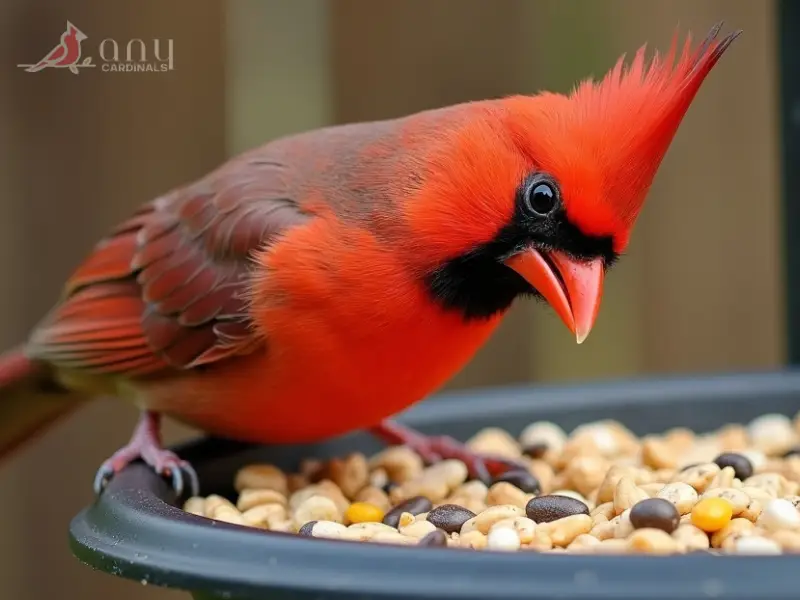
Speaking of grains, this colorful bird regularly consumes Corn, Wheat, Oats, Barley, Rye, Sorghum, and Rice.
Cardinals eat seeds and grains as these foods are rich sources of carbohydrates, providing cardinals with the required energy they need to perform daily activities such as foraging, flying, etc.
Alongside carbohydrates, many seeds feature protein and healthy fats essential for cardinal growth.
FYI, different seeds and grains offer a variety of essential nutrients, including vitamins, minerals, and antioxidants. These nutrients are crucial for the cardinal’s overall health.
Seeds and grains are vital components of the cardinal’s diet, ensuring this bird’s health, survival, and reproductive success.
Fruits and Berries
The Northern Cardinal eats various fruits and berries. Its diet includes blueberry bushes, mulberry trees, elderberries, blackberries, raspberries, mulberries, serviceberries, holly berries, and dogwood berries.
Additionally, this medium-sized songbird consumes apples, oranges, grapes, cherries, strawberries, and cranberries. The Northern Cardinal eats such food types as they contain carbohydrates and sugars.
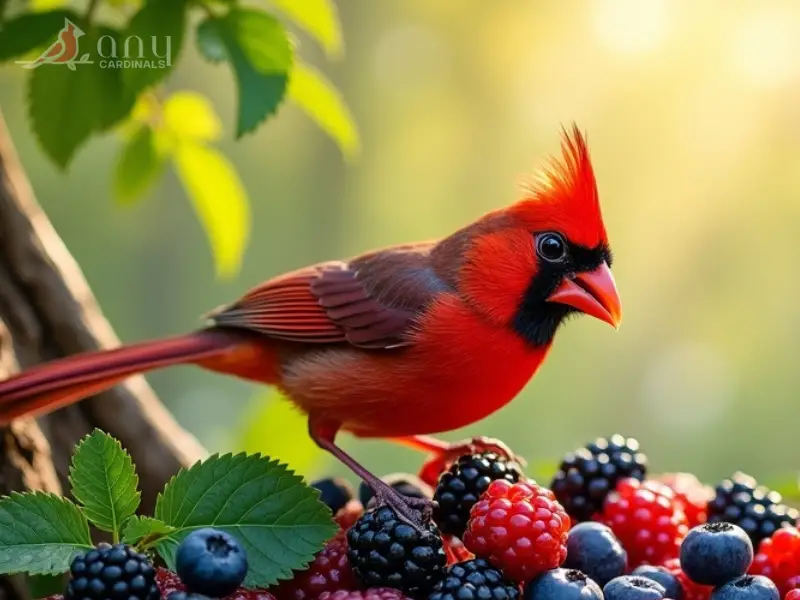
These elements serve as a quick energy source for cardinals. These foods help cardinals maintain their activity levels, especially during breeding.
You may know many fruits and berries contain water content, which helps cardinals stay hydrated, especially during hot weather or in dry environments. That’s why you may notice cardinals frequently eating fruits and berries during summer.
Insects and Invertebrates
Cardinals regularly eat various insects and invertebrates, especially during breeding season. At this time, these birdies require additional protein to stay active throughout the day.
Let’s now discuss what types of insects and invertebrates’ cardinals consume. These birds eat beetles, caterpillars, grasshoppers, crickets, ants, flies, moths, and earthworms.
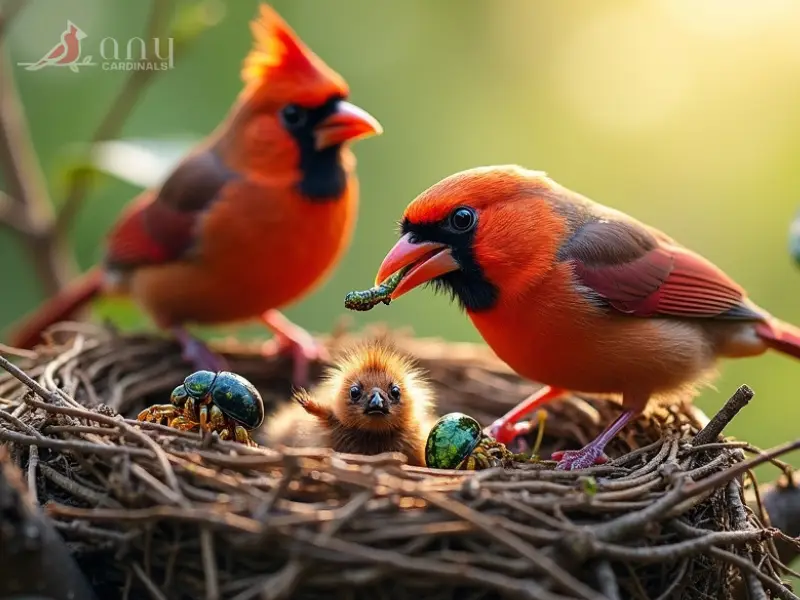
Also, they consume butterflies, spiders, centipedes, millipedes, snails, and slugs. Cardinals eat these insects as they are a high-protein food source. They are essential for young cardinals’ growth and development.
Hence, adult cardinals feed their nestlings these insects during the breeding season. Besides nestlings, adult cardinals consume these foods to add variety to their diet.
Other Food Sources
Alongside eating seeds, fruits, insects, and invertebrates, the Northern Cardinal consumes various other foods, including leaf buds, flowers, nectar, and human-provided food.
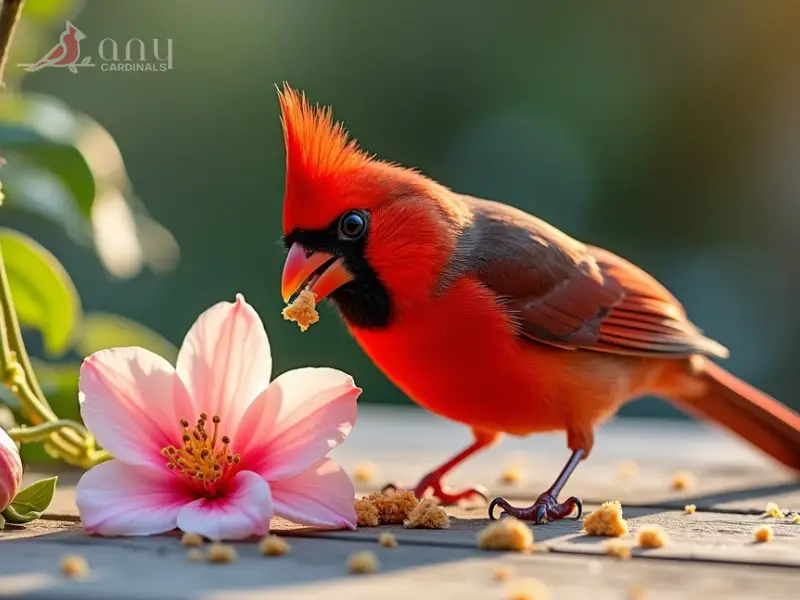
Cardinals are pretty adaptable when it comes to their diet. We will learn more about their food adaptability based on seasonal changes.
Adaptable Eaters: Seasonal Shifts
Cardinals rely more on fruits and insects for energy and chick-rearing during summer. At this time, they need to remain active and perform labor-intensive jobs such as foraging for food for hours.
So, they need protein to pull off these tasks. That’s why cardinals prefer insects and fruits during hot days. Contrastingly, they consume seeds and suet in winter for survival.
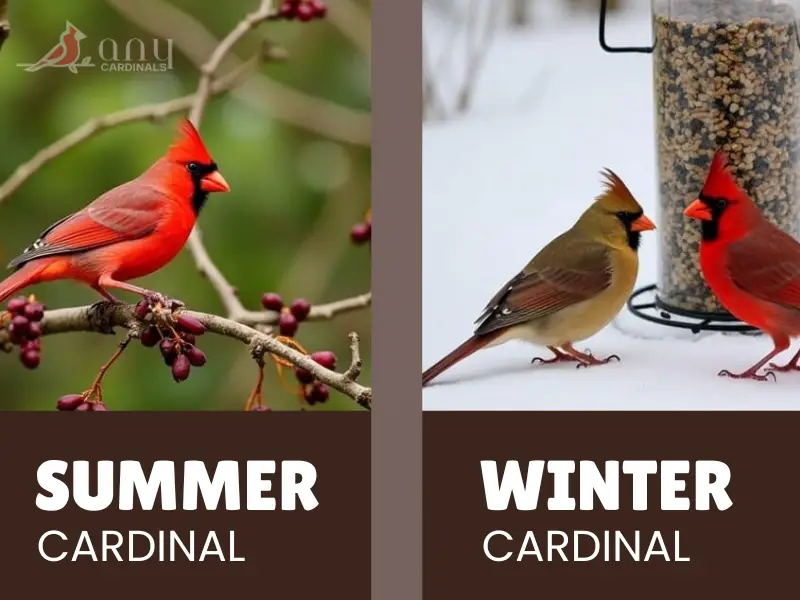
During winter, cardinals face challenges while foraging for food. Mostly, they don’t find food as easily as they used to get in summer.
Hence, whenever a group of cardinals find a food source, they start competing to collect food. The opposite happens in summer. At that time, cardinals share food with others, especially while feeding from bird feeders.
Frequently Asked Questions
What Is the Feeding Behavior of Cardinals?
Cardinal feeding behavior changes depending on various reasons. For example, the Northern Cardinal – a male bird – remains incredibly busy collecting food during the breeding season.
Other times, this bird stays calm, eats food like usual birds, and shares food with others.
Why Don’t Cardinals Eat from Feeders?
The reason can be inappropriate bird feeders. The Northern Cardinal doesn’t like feeding from small or tube feeders.
Since cardinals are medium-sized birds, they prefer large feeders where they can comfortably perch.

So, changing your bird feeders can address this issue.
What Time of Day Do Cardinals Feed?
Although you can spot the Northern Cardinals on your bird feeders at any time of the day, these birds usually feed at dawn and dusk.
Final Words
You now know everything about cardinal food habits. Cardinals are omnivores whose diet consists of seeds, insects, and fruits. Primarily, cardinals rely on various seeds to satisfy their hunger.
They also consume insects and different fruits based on their circumstances, which you already know. However, that’s all for this article.
We think it delivered the information you were seeking. Thanks for reading.
Article References:
- http://www.biokids.umich.edu/critters/Cardinalis_cardinalis/
- https://www.allaboutbirds.org/guide/Northern_Cardinal/lifehistory
- https://animaldiversity.org/accounts/Cardinalis_cardinalis/
- https://nhpbs.org/natureworks/cardinal.htm

